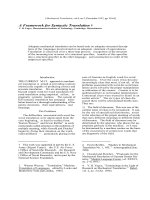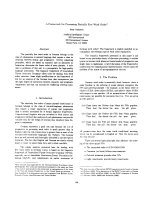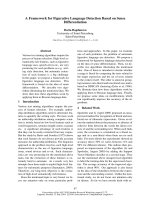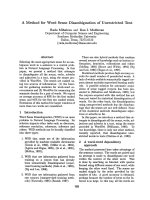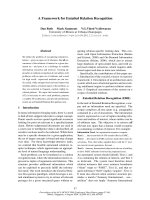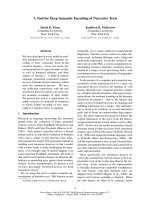báo cáo sinh học:" A framework for evaluating the impact of the United Nations fellowship programmes" ppt
Bạn đang xem bản rút gọn của tài liệu. Xem và tải ngay bản đầy đủ của tài liệu tại đây (307.91 KB, 8 trang )
METH O D O LOG Y Open Access
A framework for evaluating the impact of the
United Nations fellowship programmes
Arie Rotem
1
, Michael A Zinovieff
2
, Alexandre Goubarev
3*
Abstract
The United Nations (UN) System’s agencies have been criticize d for not adequately assessing the impact of their
training and fellowship programmes. Critics point out that beyond documentation of the number of fellows that
underwent training, and their immediate reaction to the experience, it is necessary to ascertain that fellows are
using what they have learned, and most importantly that their institution and cou ntry are benefiting from the
significant investments made in the fellowship programmes.
This paper presents an evaluation framework that was adopted by the 17th Meeting of the UN System Senior
Fellowship Officers convened in London in 2008 in response to this challenge. It is arranged in three sections. First,
the assumptions and constraints concerning impact evaluation of training are presented. Second, a framework for
evaluating the impact of training in the context of UN System programmes is proposed. Third, necessary condi-
tions and supportive measures to enable implementation of the impact evaluation framework are identified.
The critical message emerging from this review is the importance of constructing a ‘performance story’ based on
key milestones associated with the design and implementation of fellowship programmes as a way of assessing
the contribution of different components of the fellowship programmes to institutional outcomes.
Background
The United Nations (UN) System’s agencies have been
criticized for not adequately assessing the impact of
their training and fellowship programmes [1]. C ritics
point out that beyond documentation of the number of
fellows that underwent training, and their immediate
reaction to the experience, it is necessary to ascertain
that fel lows are using what they have lear ned, and most
importantly that their institution and country are bene-
fiting from the significant investments made in the fel-
lowship programmes.
In response to these concerns, the 16
th
Meeting of the
UN System Senior Fellowship Officers (Paris, November
2006) mandated the design of a generic evaluation fra-
mework that defines the scope, dimensions and core
indicators for evaluating the impact of UN Fellowship
programmes [2].
This paper presents an ev aluation framework that was
adopted by the 17th Meeting of the UN System Senior
Fellowship Officers (London, November 2008). It is
arranged in three major sections. First, the assumptions
and constraints concerning impact evaluation of training
are presented. Second, a framework for evaluating the
impact of training in the context of UN System pro-
grammes is proposed. Third, necessary conditions and
supportive measures to enable implementation of the
impact evaluation framework are identified.
Modalities of fellowships
In its detailed and well received 1998 report on “Fellow-
ships in the United Nations System” the Joint Inspection
Unit (JIU) proposed the following definition;
“ a fellowship in the United Nations system is a
specially tailored or selected training activity that
provides a monetary grant to a qualified individual
or group of qualified individuals for the purpose of
fulfilling special learning objectives; such training
may be of short or long duration and may take place
in an appropriate training i nstitution or in the field
inside or outside the fellow’scountry;shouldbein
response to nationally-approved human reso urces
policies and plans and should aim at impact and
relevance for all stakeholders involved [3].
* Correspondence:
3
Department of Human Resources for Health, WHO, Geneva
Rotem et al. Human Resources for Health 2010, 8:7
/>© 2010 Rotem et al; licensee BioMed Central L td. This is an Open Access article distributed under th e terms of the Creative Commons
Attribution License (htt p://creativecommons.org/licenses/by/2.0), which permits unrestricted use, distribution, and reproduction in
any medium, pro vided the original work is properly cited.
It should be noted that the JIU definition has not been
accepted by all UN agencies. Some agencies exclude
study tours, while others actually include seminars and
workshops. Moreover, the financial commitment of fel-
lowships has not been ac cepted by all. Some bilateral
and multilateral institutions outside the UN syst em put
the emphasis on the extent to which any fellowships
modality contributes to the achievement of clearly
defined organizational objectives rather than on the defi-
nition of fellowships. Such a determination can only be
ventured on the basis of evaluation of the effectiveness
of fellowships in all its modalities. Noting that evalua-
tion is the Achilles heel in most UN organizations , the
JIU report acknowledge that effectiveness of fellowship
in all its modalities is fundamentally linked to assessi ng
its benefits to individuals and institutions.
Evaluating fellowship programmes
Classification of different type of measures abound. In
the context of training, none is more influential than
Kirkpatrick [4,5], who proposed in the late fifties a fra-
mework for evaluating training using four levels of mea-
surement:
a) Reaction - a measure of satisfaction (what the
trainees/fellows thought and felt about the training);
b) Learning - a measure of learning (the resulting
increase in knowledge or capability as reflected in
end of course assessment);
c) Behaviour - a measure of behaviour change
(extent of behaviour and capability improvement as
reflected in on the job performance);
d) Results - a measure of results (the effects on the
institutional environment resulting from the fellows’
performance).
Kirkpatrick followers have suggested additional levels
including, for example the introduction of a fifth level
concerning estimation of the Return on Investment
(ROI) [6]. Other useful additions before and after train-
ing include an assessment of the planning, design and
implementation of the training programme and evalua-
tion of the long term benefits to particular target groups
and the social system at large.
Basing an impact evaluation framework on the
strength of Kirkpatrick work mandates two important
observations. First, it is necessary to note that most of
Kirkpatrick’s and his followers work were undertaken in
the context of corporate training, whereby the trainees
were also employees trained for well defined purposes.
In these circumstances it has been possible to assess the
training outcomes in relation to institutiona l key results
areas and to estimate the returns on training invest-
ments. UN System fellows, on the other hand, return to
different organisations and the impact of their learning
on their home institutions is infinitely more difficult to
assess due to limited control over their deployment and
support once the fellowship is completed.
The second observation is even more pertinent.
Although Kirkpatrick’s 4 step approach has been widely
discussed in the literature, it is evident that most organi-
sations have not evaluated all four levels. Training inter-
ventions have been typically evaluated at the reaction
and learning levels. Only a few studies have paid atten-
tion to behavioural outcomes, and ver y few assessed the
benefit to organisations. The reliance on fellows’ reac-
tion and learning measures may reflect the difficulty and
cost associated with measuring performance and organi-
zational benefits and may underpin the limitation of
current approaches [7].
Recognising the constraints
Key constraints associated with the assessment of t he
impact of training include:
Methodological constraints
(a) Methodological constraints associated with the attri-
bution of any impact or change in the performance of
individuals or systems to the participation in fellowship
programmes. R eporting results and ‘proving’ attribut ion
are two different things. Attribution involves drawing
causal links and explanatory conclusions between
observed changes and specific interventions [8]. If we
wish to draw conclusions about the value of the pro-
gramme and make decisions about its future direction
we are expected to demo nstrate that the progra mme
contributed to the attainment of particular outcomes
[9]. These links could be relatively easy to establish at a
productoroutputlevel.Itismuchmoredifficultto
attribute impact at higher levels (programme, agency,
sectoral or national outcomes), or in complex systems.
Determining whether an outcome was caused by a parti-
cular programme, partner programmes, other donor
activities, or societal change, is difficult to substantiate.
Conceptual constraints
(b) Conceptual constraints associated with the expecta-
tion that training on its own would have a sustainable
impact on the system evaluated. Change in performance
is commonly based on a multi prong intervention of
which “people development” is only one of the elements.
Conceptually there is no basis to expect that training
alone would influence the perfo rmance of complex sys-
tems in the absence of contributing factors such as
appropriate technology, resources, leadership, favourable
internal and external conditions, conducive formal
structure and most importantly supportive organiza-
tional culture.
Rotem et al. Human Resources for Health 2010, 8:7
/>Page 2 of 8
Programme fidelity
(c) The challenge of programme me fidelity. Experience
with some UN System programmes have shown that fel-
lowships are not always linked to well articulated objec-
tives, that the selection process may be skewed, that the
host institutions and programmes often lack under-
standing of the training needs, that fellows return to set-
tings that fail to support and utilize them properly, and
other such deficiencies. Furthermore, there is a great
variability in the design and implementation of fellow-
ship programmes in terms of duration, mode of training,
recipient instruction resources and capacity and other
variables. The fidelity of the fellowship programme as
reflected in the presence of these critical determinants
should arguably be demonstrated before major invest-
ments are made in the measurement of impact.
Addressing common constraints
Whilst it is not possible to completely eliminate these
constraints,itmaybepossibletomitigatetheireffect.
The mapping of the entire pathway, from the initial iden-
tification of training needs and selection of fellows to the
assessment of the support for and utilization of fellows in
the home institution provides what Brinkerhoff and Gill
[10] called an “impact map”. T he milestones signalled in
this kind of map may help to verify the fidelity of the pro-
gramme and at the same time help to ide ntify the factors
that affect progress towards outcomes.
In turn, the mapping of the fellowship programme
pathway will improve our understanding of the added
contribution of each component of the fellowship pro-
gramme, helping us to attribute their contribution to
the overall impact and improving our understanding of
the role of training in the context of a broader capacity
building effort. Most importantly, it should help us to
verify that fellowship programmes have clear and well
understood objectives in line with recipient institutions’
priorities, that the programmes were well designed and
funded, that the right people were sele cted and partici-
pated, that the training they received was consistent
with their work settings requirements, that they gained
the skill and knowledge they required, that they
returned home and were posted in relevant positions,
that they were given necessary support and o pportunity,
that they were able to apply their newly acquired com-
petencies in practice, that their performance lead to
improvement in programmes and institutional perfor-
mance and ultimately that the programmes benefited
particular customers or communities. In theory each
step is a logical necessary condition for the success of
subsequent steps. We could view these steps as a ‘hier-
archy of outcomes’ we wish to achieve and hence need
to monitor and evaluate.
The contribution analysis approach
Thenotionofmappingthepathwaytowardshigher
level goals is consistent with Mayne’s Contribution Ana-
lyses approach [11]. According to Kotvojs and Shrimp-
ton [12], who have applied the contribution analysis in
the context of an international development aid project,
contribution analyses could address the challenge of
attribution and verification of the logic of any pro-
gramme (what we could reasonably expect). The
approach is well su ited to development programmes
where data is likely to reflect ‘progress toward results’,
rather than a definitive statement of final outcomes. As
they point out “ , there is no expectation in Mayne’s
approach that causality can be firmly established, or that
assessing a programme’s contribution to outcomes
should be conducted solely through quantitative meth-
ods. Mayne’s [9] broader approach to Contribution Ana-
lysis seeks to achieve what Hendricks calls a ‘plausible
associati on’,wherebya‘reasonable person, knowing
what has occurred in the programme and that intended
outcomes actually occurred, agrees that the programme
contributed to those outcomes’ (cited in [9]).
Thus, as Mayne [9] suggested, developing a results
chain, and assessing alternative explanations for out-
comes, enables us to produce a plausible ‘performance
story’,andinturn,toestimatethedegreetowhich
results could be attributed to particular interventions.
As Iverson [8] has noted, “contribution analysis accepts
that in order to create a ‘credible picture of attributi on’,
complexity is recognised, multiple influences acknowl-
edged and mixed methods used to ‘gain (an) under-
standing of what programmes work, what parts of which
programmes work, why they worked, and in what con-
texts"’. (Cited in [12])
Systematic review of the pathway towards
higher goals
Whilst most UN System agencies have monitored some
of the key milestones re lated to the result chain of a fel-
lowship programme, it appears that the link between
these steps as a pathway leading to impact has not been
explored systematically. The Logframe approach which
is used by many agencies in project design and monitor-
ing, points in th e right direction. By linking higher level
goals to specific objectives , activities and inputs, the fra-
mework enables clarity about the pathway. The inclu-
sion of indicators for verification of progress and
attainment of goals provide s a blue print for monitoring
and evaluation and the identification of barriers along
the way.
The World Bank evaluation indicators [13] which
were applied to the fellowship context by the WHO
Senior Fellowship Officers make a good contribution in
Rotem et al. Human Resources for Health 2010, 8:7
/>Page 3 of 8
this regard. The WB framework provides a number of
dimensions that are consistent with the notion of ‘mile-
stones’ discussed above. For example, verifying that the
selection of participants to a fellowship programme is
based on priority needs addresses indicators related to
‘Relevance’. Review of the design and implementation of
the fellowship programme may address the criteria of
‘Effectiveness’, ‘Efficiency’ and ‘Sustainability’ . The vali-
dation of these criteria opens the way for further
exploration concerning the longer term impact of fel-
lowships on the performance of institutions and
services.
The critical message emerging from these assumptions
and assertions is the importance of constructing a ‘per-
formance story’ based on key milestones associated with
the design and implementation of fellowship pro-
grammes, as a way of assessing the contribution of dif-
ferent components of the fellowship programmes to
institutional outcomes [14,15].
A generic framework for evaluating the impact of
fellowship programmes
The proposed f ramework for e valuating the impact of
UN System fellowships is based on an attempt to ana-
lyse the contrib ution of different events and experiences
to the attainment of particular results. The emerging
performance story enables ‘reasonable’ observers to
determine the plausib ility that particular interventions
led to certain results. The perf ormance story describes
the journey from the inception of a fellowship pro-
gramme to the attainment of its immediate and long
term goals. The important events and experiences along
the way are identified as milestones (performance indi-
cators) that are monitored in order to ascertain that the
programme is moving in the right d irection and ulti-
mately it has reached its destination. (See Additional
File 1 for a summary of sample indicators and methods
of data collection that may be used to review the key
milestones).
The verification that certain milestones have been
reached strengthens our confidence in the contribution
of particular outcomes towards the results (attribution)
and reduces uncertainties associated with alternative
explanations. In addition, the proposed analysis aims to
explore the fidelity of the fellowship programme by
ascertaining the fulfilment of necessary steps that lead
us to expect that the fellowship intervention produce
benefits to the recipient institutions.
The proposed evaluation framework focuses on both
qualitative and quantitative evidence concerning the
attainment of milestones implied in the extended Kirk-
patrick classification of training evaluation measures. In
addition to the four domains suggested by Kirkpatrick
(reaction, learning, behaviour, results) we include the
domains of planning, design and implementat ion and
the long term impact (’mega-impact’) of t he fellowship
programme.
The data collection methods are varied to provide a
triangulation that may increase our confidence in the
emerging findings. We stressthebenefitofusingexist-
ing information through secondary analysis of records
and reports. Information routinely kept by institutions
and fellowship authorities, is more economical to obtain
and less likely to be biased. Accessing existing data,
however, requires close collaboration with recipient
institutions, fellowship authorities and other relevant
stakeholders. Engagement of stakeholders in the elicita-
tion of information and the interpretation of what it
means is an essential component of this approach, as we
rely on a deeper understandi ng of contextual issues and
conditions which may affect the results. Furthermore,
the involvement of stakeholders supports the emergence
of ownership, an essential condition for capacity build-
ing and lasting improvement.
Key milestones pathway for impact assessment of
fellowships
Figure 1 presents the logic pathwa y and benefit chain
that should be monitored to ascertain the benefits of the
fellowship program.
Key indicators include:
• Clear objectives:
- aligned with national priorities and UN Agen-
cies’ mandates.
- based on training needs analysis.
- articulated in an achievable and cost effective
education and training plan.
• Fair and transparent selection of fellows based on
established selection criteria
• Relevant and appropriate placement of fellows
using host institution with relevant expertise and
adequate resources to provide an effective and effi-
cient programme
• Successful and timely completion of fellows’
programme:
- accomplished educat ion and training objectives
and certification of competence, where applicable
(Evidence of learning gained through the
fellowship).
- resulting in positive feedback from fellows and
other stakeholders (found the learning experience
suitable and beneficial and would recommend
similar arrangements to their colleagues).
• Return home to relevant position with adequate
support:
- percentage of fellows who are employed in rele-
vant positions following various intervals of time.
Rotem et al. Human Resources for Health 2010, 8:7
/>Page 4 of 8
- level and appropriateness of support provided
to returning fellows (mentoring).
• Evidence of positive contribution to work:
-selfandothers’ reports about enhanced capa-
city and contribution with concrete and verifiable
examples (changes in behaviour or performance
that could be reasonably attributed to the learn-
ing experience offered by the fellowship).
- continuing professional and personal develop-
ment, and contribution to others’ learning
(dissemination).
- increasing productivity.
• Evidence of positive development in performance:
- examples of new programmes or innovative
ways of working (including new technologies)
that led to more effective performance.
- bridging operational gaps.
- strengthened professional networks.
• Improved performance leading to enhanced ser-
vices and benefits provided to community:
- evidence concerning benefits to the target
community.
- contribution to attainment of development
goals including MDGs.
Supportive conditions for effective
implementation of impact evaluation of
fellowships programmes
The third objec tive of this paper is to identify necessary
conditions and supportive measures to enable
implementation of the impact evaluation framework in
the context of the UN System fellowships pro grammes.
Our comments and recommendati ons here are made
with reference to the application of contribution analysis
presented in the previous section. Underpinning this
approach is the capacity to map and monitor the key
steps (milestones) that constitute a pathway towards
impact. This task requires a high level of cooperation
among the main stakeholders in accessing, collecting
and interpreting information that supports their ability
to make a judgment about the plausibility of the emer-
ging performance story. Ascertaining the attainment o f
the selected milestones calls attention to the fidelity of
the programme as we do not have reason to expect long
term impact unless we implement the fellowship pro-
gramme properly.
The development of a clear pathway implies clear
direction. Fellowship programmes that are intended to
have impact on the recipient in stitution should be based
on clear analysis of what needs to be developed or
strengthened and how training could contribute. With-
out such direction it is not clear what the fellowship is
expected to achieve and to assess its contribution. This
information provides a baseline against which progress
can be measured and impact determined. If we don’t
know the situation at the starting point we could not
argue that we have adde d value, nor can we take credit
for an improved state of affairs. The initial analysis
of training needs provides an a ssessment of the level
of competence before t raining and enables verification
Figure 1 Logic Pathway and Benefit Chain to be monitored to ascertain the benefits of the fellowship programme.
Rotem et al. Human Resources for Health 2010, 8:7
/>Page 5 of 8
of learning gains. Identifi cation of institutional perfor-
mance gaps as justification for the fellowship provides a
yardstick against which we can measure progress.
Clarity about the recipient system requirements and
training needs is essential to guide all aspects of the fel-
lowship programme design, from selection of fellows
who are most likely to succeed and contribute, to the
desi gn of appropriate training programmes and the pre-
paration of plans for placement and utilisation of fellows
on completion of th e programme. To be useful, this
information must be made available to the host institu-
tions and used to monitor the relevance of the training
programme provided. Lack of adequate follow up and
support to returning fellows is among the greatest risks
to the attainment of the higher level institutional goals,
as frequently observed fellows a re not given s ufficient
opportunity to contribute in the areas of expertise they
may have acquired. In this way the effectiveness and
contribution of the fellowship to the institution is
diminished. The contribution analysis may he lp to iden-
tify the disjointed pathway, but beyond a certain time-
frame the damage may be irreversible.
To achieve a meaningful progression from analysis
and identification of needs to appropriate intervention
and subsequent utilisation that leads to sustainable ben-
efits and impact requires a solid partnership between
the recipients, the providers and the sponsors of the fel-
lowship programme. As mentioned earlier, one of the
key weaknesses of the UN fellowship programme is that
most of the important steps a re outside the term of
reference of the sponsoring agency and thus beyond its
control. This weakness needs to be remedied through
stronger collaboration and contractual arrangements
concerning the execution of the fellowship programme.
The active involvement of relevant stakeholder is a cor-
nerstone of the contribution analysis approach. Partner-
ship is required at all steps.
Approaches based on stakeholder participation are
built on the principle that stakeholders should be
involved in all stages of evaluation, including determining
objectives and impacts, identifying and selecting indica-
tors, and participating in data collection and analysis.
The stakeholders are essential participants in assessing
the contributions towards impact based on the emerging
performance story. Their involvement and subsequent
ownership of the findings increases th e chance that defi-
ciencies would be addressed and opportunities taken up.
Conclusions
Beyond the high level of commitment and resources
required to undertake impact evaluation, it is necessary
to recognize three major limitations in evaluating the
impact of fellowship programmes:
• Attribution: what would have happened without
the intervention?
• Conceptual logic: why is impact expected?
• Fidelity: based on the way the programme was
implemented is it justified to expect impact?
Monitoring key milestones from conception to fruition
of a fellowship programme mitigates these limitations by
assessing the importance and contribution of each step
onthelogicalpathwaytowards training impact and
ascertaining that the f ellowship programme has been
implemented properly within a logical conceptual frame-
work. Whilst the contribution analysis approach may
notbeabletoprovidethecasualrelationsamongvari-
ables leading to an impact, it could establish a ‘plaus ible
association’ whereby a ‘reasonable person , knowing what
has occurred in the programme and that the intended
outcomes actually occurred, agrees that the programme
contributed to particular outcomes.
The performance story which emerges from this analysis
enables ‘reasonable’ observers to determine the plausibility
that particular interventions have led to certain results.
The performan ce story descri bes the journe y from the
inception of a fellowship programme to the attainment of
its immediate and long term goals. The important events
and experiences along the way are identified as milestones
that could be monitored in order to ascertain that the pro-
gramme is leading in the right direction and ultimately
that it reached its ultimate goals. The verification that cer-
tain milestones have been reached strengthens the confi-
dence that particular contributions helped to attain
particular results (attribution) and reduces the uncertain-
ties associated with alternative explanations. In addition,
the proposed analysis aims to explore the fidelity of the
fellowship programme by ascertaining the fulfillment of
necessary steps that justif y the expectation of the fello w-
ship producing benefits to the recipient institutions.
The proposed evaluation framework focuses on both
qualitative and quantitative evidence concerning the
attainment of milestones implied in the extended Kirk-
patrick classification of training measures. In addition to
the four domains suggested by Kirkpatrick (reaction,
learning, behavior, and results) are the pre-training
domain of planning, design and implementation, and
thelongtermimpact(’mega-impact’) following the
training programme.
A major advantage of the co ntribution analysis
approach is that it can be based on assessment of a ny
plausible evidence regardless of the design, method or
source used to obtain it. Thus, it allows use of informa-
tion obtained through current monitoring and evalua-
tion approaches and techniques. The use of varied data
collection methods provides triangulation of findings.
Rotem et al. Human Resources for Health 2010, 8:7
/>Page 6 of 8
Accessing existing data sources requires close colla-
boration with recipient institutions, fellowship authori-
ties and other relevant stakeholders. The task re quires a
high level of cooperation among the main stakeholders
in accessing, collecting and interpreting information that
supports their ability to make a judgment about the
plausibility of the emerging performance story. Engage-
ment of stakeholders in the elicitation of information
and the interpretation of what it means is an essential
component of this approach, a s we rely on their deeper
understanding of contextual issues and conditions which
may affect the results. Furthermore, their involvement
supports the emergence of ownership, an essential con-
dition for capacity building and lasting improvement.
Effective use of evaluation towards improvement of
programmes and determining their merit requires a sup-
portive evaluation culture. Evaluation culture values evi-
dence as a basis for decision making and support s
monitoring of outcomes obtained at different stages.
Evaluation is viewed as an integral part of planning and
managing programmes, from identification of needs,
design and i mplementation of strategies and pro-
grammes, to assessing outputs and outco mes towards
impacts. At each stage, important decisions are made
and information is required. T he process is based on
partnership and continuing dialogue with key stake-
holders about the contributions made by different inter-
ventions towards higher level goals.
The recommended approach requires major efforts
and investmen ts not undertaken to date. Eval uation
does cost but “spending whatever limited funds are
made available for a fellowship programme without hav-
ing any reasonable indication of impact is a waste of
much needed resources” [3].
Senior Fellowship Officers meeting (London,
2008): recommendation
The 17
th
meeting of the UN Senior Fellowship Officers
gave the following verdict on the framework:
“Having considered the various possible evaluation
approaches for impact assessment presented during the
meeting, by the Task Force experts, led by WHO pur-
suant to the mandate received during the 16
th
Senior Fel-
lowship Meeting, and following the deliberations on the
resulting findings, the Meeting has found particular mer-
its in the Contribution Analysis approach and therefore
adopts this specific modality, with the elaborated mile-
stones pathway as the platform for future implementa-
tion and evaluation of Training and Fellowship Capacity
Development activities within the UN system” [16].
Additional file 1: Indicators and methods for evaluation of the six
stages of fellowship.
Acknowledgements
We would like to express our deep appreciation to the WHO Department of
Human Resources for Health for inviting us to undertake this review on
behalf of the UN System Task Force on Impact Assessment of fellowships.
We are grateful to Furio De Tomassi, Davide Tonini and Curtis V. Hosang
from the UN Department of Economic and Social Affairs for convening the
Senior Fellowship Officers’ meeting and ably facilitating the resolution
concerning impact evaluation. The contribution to the development of this
evaluation framework by the SFO representing different UN agencies and a
number of development partners is gratefully acknowledged. We also wish
to extend our appreciation to Tai Rotem for his very valuable contribution
to the identification and review of research designs and methods applicable
to the evaluation framework presented in this report.
Author details
1
School of Public Health and Community Medicine, UNSW, Sydney, Australia.
2
Consultant in Human Resources, Geneva, Switzerland.
3
Department of
Human Resources for Health, WHO, Geneva.
Authors’ contributions
AR was primarily responsible for the formulation of the evaluation
framework and for drafting the paper. MZ was primarily responsible for the
literature review and AG contributed to the formulation of the outline of
this review. All three authors contributed to the identification of supportive
conditions for implementation of the framework and the formulation of the
conclusions. All authors read and approved the final manuscript.
Competing interests
The authors declare that they have no competing interests.
Received: 5 July 2009 Accepted: 30 March 2010
Published: 30 March 2010
References
1. Regional Workshops on UNDP Evaluation Policy 2006-07. [http://www.
undp.org/eo/documents/workshop/regional_ws/wsr-summary.pdf].
2. 16th Meeting of Senior Fellowships Officers of the United Nations System and
Host Country Agencies, Paris, 6 - 8 November 2006, Final Report United
Nations, New York 2007.
3. Fellowships in the United Nations System. [ />reports/1998/en98_01.pdf].
4. Kirkpatrick DL: Evaluating Training Programmes: The Four Levels
San Francisco, CA: Berrett-Koehler 1994.
5. Kirkpatrick’s learning and training evaluation theory. [http://www.
businessballs.com/kirkpatricklearningevaluationmodel.htm].
6. Phillips J: Return on Investment in Training and Performance Improvement
Programs Massachusetts, USA: Butterworth-Heinemann 2003.
7. Alliger GM, Janak EA: Kirkpatrick’s levels of training criteria: thirty years
later. Personnel Psychology 1989, 42(2):331-342.
8. Iverson A: Attribution and aid evaluation in international development: a
literature review, prepared for CIDA Evaluation Unit, International Development
Research Centre 2003.
9. Mayne J: Addressing attribution through contribution analysis: using
performance measures sensibly. The Canadian Journal of Programme
Evaluation 2001, 16(1):1-24.
10. Brinkerhoff R, Gill S: Managing the total quality of training. Human
Resource Development Quarterly 1992, 3(2):121-131.
11. Mayne J: Addressing attribution through contribution analysis: using
performance measures sensibly: discussion paper, Office of the Auditor General
of Canada 1999.
Rotem et al. Human Resources for Health 2010, 8:7
/>Page 7 of 8
12. Kotvojs F, Shrimpton B: Contribution Analysis - A new approach to
evaluation in international development. Evaluation Journal of Australia
2007, 7(1):27-35.
13. An Introduction to IEG for First Time Visitors. [ />ieg/intro].
14. Hendricks M: Performance monitoring: how to measure effectively the results
of our efforts’, paper presented at the American Evaluation Association Annual
Conference, Atlanta 1996.
15. Dart J, Mayne J: Performance story. Encyclopedia of valuation Sage.
California: Thousand OaksMathison S 2004.
16. 17th Meeting of Senior Fellowships Officers of the United Nations System and
Host Country Agencies, IMO, London, 17-19 November 2008, Final Report
United Nations, New York 2009.
doi:10.1186/1478-4491-8-7
Cite this article as: Rotem et al .: A framework for evaluating the impact
of the United Nations fellowship programmes. Human Resources for
Health 2010 8:7.
Submit your next manuscript to BioMed Central
and take full advantage of:
• Convenient online submission
• Thorough peer review
• No space constraints or color figure charges
• Immediate publication on acceptance
• Inclusion in PubMed, CAS, Scopus and Google Scholar
• Research which is freely available for redistribution
Submit your manuscript at
www.biomedcentral.com/submit
Rotem et al. Human Resources for Health 2010, 8:7
/>Page 8 of 8
